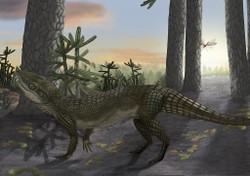ANI. 24 July 2015. “Newly Discovered ‘Four-legged’ Fossil Sheds Light on Snakes’ Evolution.” Yahoo! News India > Tech. Retrieved August 2015.
- Available @ https://in.news.yahoo.com/newly-discovered-four-legged-fossil-sheds-light-snakes-104217651.html
Bednar, Chuck. 24 July 2015. “Researchers Discover Fossil of Four-legged Snake.” The Daily Orbit > Natural Science. Retrieved August 2015.
- Available @ http://thedailyorbit.com/researchers-discover-fossils-of-four-legged-snake-072415/
Cameron, Charley. 27 July 2015. “Four-legged Prehistoric Snake Offers Clues about the Reptile’s Evolution.” Inhabitat. Retrieved August 2015.
- Available @ http://inhabitat.com/four-legged-prehistoric-snake-offers-clues-about-the-reptiles-evolution/
Christakou, Anastasia. 23 July 2015. “Four-legged Fossil Snake is a World First.” Nature > News & Comment > News > 2015 > July > Article. Retrieved August 2015.
- Available @ http://0-www.nature.com.ils.sidra.org/news/four-legged-fossil-snake-is-a-world-first-1.18050
Crown, Alex. 24 July 2015. “Four-legged Snake Fossil Discovered.” Lidtime > World News. Retrieved August 2015.
- Available @ http://www.lidtime.com/four-legged-snake-fossil-discovered-8385/
Engelking, Carl. 24 July 2015. “Four-legged Snake Ancestor Dug Burrows with Tiny Limbs.” Discover > Blogs > D-brief. Retrieved August 2015.
- Available @ http://blogs.discovermagazine.com/d-brief/2015/07/24/four-legged-snake/#.VcjIuSiWE5Q
Festante, Jim. 26 July 2015. “A Snake with Arms.” The Slate Group LLC > Video > Slate in Motion. Retrieved August 2015.
- Available @ http://www.slate.com/articles/video/video/2015/07/snake_arms_tetrapodophis_amplectus_fossil_discovery_shows_lizard_snake_ancestor.html
“Four-legged Fossil Holds Secret of Snake’s Slithering Origins." New Scientist: News > Life > Daily News. Retrieved August 2015.
- Available @ https://www.newscientist.com/article/dn27949-four-legged-fossil-holds-secret-of-snakes-slithering-origins/
“A Four-legged Fossil of Snake Provides Insights into Snake Evolution.” Editage Insights > Plant and Animal Science > 25 July 2015. Retrieved August 2015.
- Available @ http://www.editage.com/insights/a-four-legged-fossil-of-snake-provides-insights-into-snake-evolution
“Four-legged Fossil Suggests Snakes Evolved from Burrowing Ancestors." Eurekalert! > Public Releases. Retrieved August 2015.
- Available @ http://www.eurekalert.org/pub_releases/2015-07/aaft-ffs072015.php
“The Four-legged Hugging Snake.” BBC World Service > Science in Action > 24 July 2015. Retrieved August 2015.
- Available @ http://www.bbc.co.uk/programmes/p02x6cwh
Grant, Bob. 27 July 2015. “Four-legged Snake Fossil Found.” The Scientist > The Nutshell. Retrieved August 2015.
- Available @ http://www.the-scientist.com/?articles.view/articleNo/43604/title/Four-legged-Snake-Fossil-Found/
Locsin, Joel. 4 August 2015. “This ‘Four-legged Snake’ is Changing the Way We Think about Snake Evolution.” Newsi.NG. Retrieved August 2015.
- Available @ http://philippines.newsi.ng/news/72157-this-four-legged-snake-is-changing-the-way-we-think-about-snake-evolution
Martill, David M. 1993. Fossils of the Santana and Crato Formations, Brazil. Field Guides to Fossils No. 5. London UK: Palaeontological Association.
Martill, David M., Günter Bechly, and Robert F. Loveridge. 2007. The Crato Fossil Beds of Brazil: Window into an Ancient World. Cambridge UK; New York NY: Cambridge University Press.
Martill, David M.; Tischlinger, Helmut; and Longrich, Nicholas R. 24 July 2015. "A Four-legged Snake from the Early Cretaceous of Gondwana." Science 349(6246):416-419. Retrieved August 2015.
- Available @ doi: 10.1126/science.aaa9208
Press Office. 23 July 2015. “Four-legged Snake Fossil Found.” University of Portsmouth > UoP News > General News. Retrieved August 2015.
- Available @ http://0-www.nature.com.ils.sidra.org/news/four-legged-fossil-snake-is-a-world-first-1.18050
“Researchers Hesitate to Fully Embrace Ancient, Four-legged Snake." 2 New Things > 23 July 2015. Retrieved August 2015.
- Available @ http://2newthings.com/researchers-hesitate-to-fully-embrace-ancient-four-legged-snake/
Sabino, Julie. 23 July 2015. “Oldest Snake Fossil Has Four Legs, Partial Features of a Lizard.” Headline & Global News. Retrieved August 2015.
- Available @ http://www.hngn.com/articles/112277/20150723/oldest-snake-fossil-has-four-legs-partial-features-of-a-lizard.htm
Smith, Ginny. 28 July 2015. “The Four-legged, Hugging Snake.” The Naked Scientists > Science News. Retrieved August 2015.
- Available @ http://www.thenakedscientists.com/HTML/science-news/news/1000751/
“Snake with Feet: Oldest Snake Fossil.” Associated Post United States of America > World News. Retrieved August 2015.
- Available @ http://apusa.us/snake-with-feet-oldest-snake-fossil-34962/
Temperton, James. 24 July 2015. “Four-legged ‘Hugging Snake’ Could be a Missing Link.” Wired > News > Snakes. Retrieved August 2015.
- Available @ http://www.wired.co.uk/news/archive/2015-07/24/four-legged-hugging-snake-fossil
“Tetrapodophis amplectus.” The World of Animals > Terrestrial Animals > 26 July 2015. Retrieved August 2015.
- Available @ http://theworldofanimals.proboards.com/thread/1144/tetrapodophis-amplectus?page=1
Webb, Jonathan. 24 July 2015. “Four-legged Snake Ancestor ‘Dug Burrows’.” BBC News > Science & Environment. Retrieved August 2015.
- Available @ http://www.wired.co.uk/news/archive/2015-07/24/four-legged-hugging-snake-fossil
Virata, John. 5 August 2015. “Brazil Wants Possession of the Four-legged Snake Fossil.” Reptile Magazine > Snakes > Information & News. Retrieved August 2015.
- Available @ http://blogs.discovermagazine.com/science-sushi/2015/07/24/four-legged-snake-shakes-up-squamate-family-tree-or-does-it/#.VcjbOiiWE5Q
Wilcox, Christie. 24 July 2015. “Four-legged Snake Shakes up Squamate Family Tree- Or Does It?” Discover > Blogs > Science Sushi. Retrieved August 2015.
- Available @ http://blogs.discovermagazine.com/science-sushi/2015/07/24/four-legged-snake-shakes-up-squamate-family-tree-or-does-it/#.VcjbOiiWE5Q
Yong, Ed. 23 July 2015. “A Fossil Snake with Four Legs.” National Geographic Magazine > Phenomena > Not Exactly Rocket Science. Retrieved August 2015.
- Available @ http://phenomena.nationalgeographic.com/2015/07/23/a-fossil-snake-with-four-legs/
















 Are Hawaiian Huakai Po Nightmarchers Avenging Halloween Thursday?on 10/02/2024
Are Hawaiian Huakai Po Nightmarchers Avenging Halloween Thursday?on 10/02/2024
 Mailing Addresses for 2023 Form 4868 Extending 1040 and 1040SR April 15, 2024, Due Dateon 04/15/2024
Mailing Addresses for 2023 Form 4868 Extending 1040 and 1040SR April 15, 2024, Due Dateon 04/15/2024
 Mailing Addresses for 2023 Forms 1040 and 1040SR Filed in 2024on 04/15/2024
Mailing Addresses for 2023 Forms 1040 and 1040SR Filed in 2024on 04/15/2024
 Mailing Addresses for 2022 Form 4868 Extending 1040 and 1040SR April 18, 2023, Due Dateon 04/13/2023
Mailing Addresses for 2022 Form 4868 Extending 1040 and 1040SR April 18, 2023, Due Dateon 04/13/2023



Comments
blackspanielgallery, The one thing that's less frightening is the body length since so many constrictor snakes can be scary in their lengths and widths.
This indeed would be frightening to encounter.